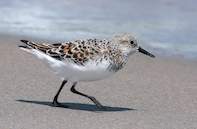
Sanderling
Name
Sanderling (Calidris alba)
Family
Scolopacidae
Length
19 cm
Appearance
The sanderling is rather dull with white below, a pale grey on the crown and upper parts and a black shoulder marking. The eyes are brown and the short heavy bill and legs black. It has no hind toe, leaving three instead of the usual four. The breeding sanderling adult is a spangled black, white, and rich rufous on the head, neck and back.
Sanderling Call
The call is a whistled ‘twick twick’.
Sanderling Migration
The sanderling is a summer migrant from the Palaearctic (Europe, Asia north of the Himalayan foothills and northern Africa).
Sanderling Diet
The sanderling runs back and forth on the beach, picking or probing for small crabs and other marine invertebrates in the wet sand left by receding waves. They forage on beaches but will also use mudflats.
Habitat
In South Africa the sanderling is a common migrant and seen from September – May along coastal sandy beaches, tidal sand flats, mud flats and the shores of lakes and rivers.
Sanderling Status
The sanderling is of least concern and a common summer visitor.
Where they are found
In South Africa the sanderling is common along the west coast and is rarely seen inland.

